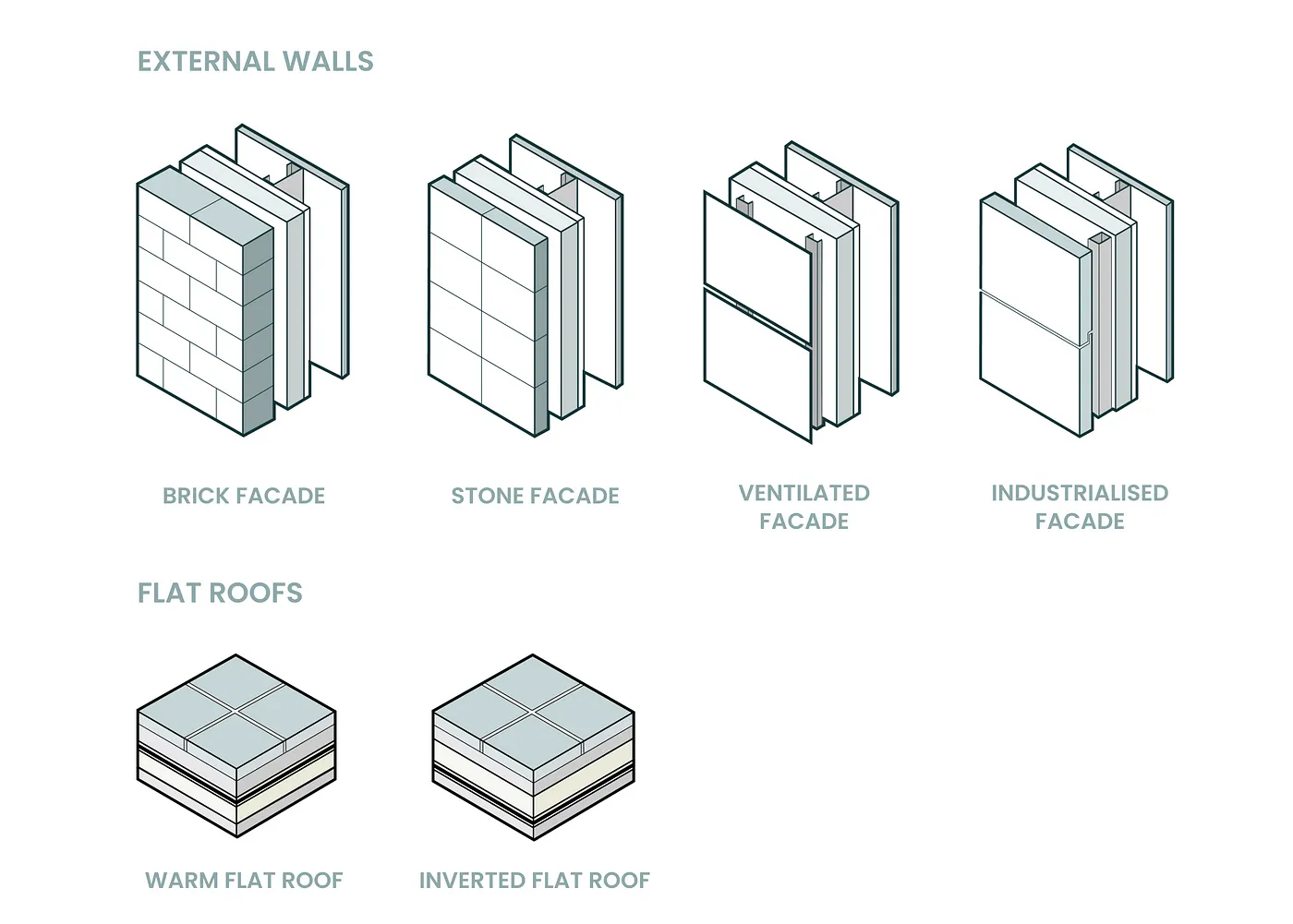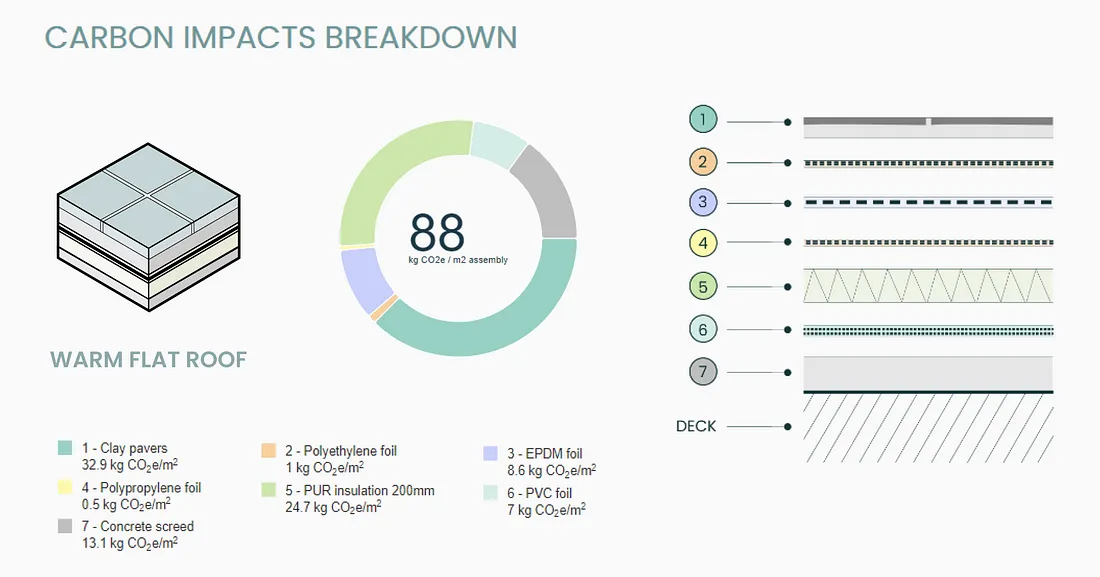Assess Environmental Impacts of Flat Roof Systems with Embodied Carbon Optimizer Tool
2050 Materials has extended the Embodied Carbon Optimizer tool into new building envelope assemblies. Flat Roof Systems are now available, apart from the different External Wall Systems previously integrated (Brick Facade, Stone Facade, Ventilated Facade, Industrialised Facade).

Building envelope systems that are currently available at Embodied Carbon Tool.
The updated Embodied Carbon Optimizer tool provides a simplified LCA for early design phases to quickly compare the climate impacts of Warm and Inverted Flat Roofs. The tool aims to be interactive to ease the translation of roofing material choices into simplified constructive details while navigating through dynamic environmental impact breakdowns (A1-A3 modules) displayed per material and system.
Warm and Inverted Flat Roofs
Basically, the difference between these two roof systems lies in where the insulation sits in relation to the waterproofing layer:
- Warm Flat Roof. The insulation is placed above the structural deck but beneath the waterproof membrane, helping to retain heat within the building.
- Inverted Flat Roof. The waterproof membrane is placed below the thermal insulation, with insulation covered by a layer of ballast or protection, offering added thermal mass and protection to the waterproofing layer.
Multiple material selection per roof component
The Embodied Carbon Optimizer tool for flat roofs is designed to be customised according to the main function of the roof components. Due to its complexity and variety, the deck and any other structural components aren’t included in this envelope LCA assessment. The basic flat roof components that can be found in the materials dropdown are Roof covering, Insulation, and Waterproofing.
Screed and roof membranes (separation foils, anti-puncture foils, breathable membranes, filter layers, and vapour barriers) are included in the component selection as optional during the assembly customisation. The decision to add these components depends on the desirable combination of materials and subsequent overall performance and materials compatibility within the assembly.
This multiple-choice option for building materials is also translated into various simplified constructive details by offering 8 assembly configurations per flat roof system, depending on the selection of additional components.

Example of simplified constructive details for Warm Flat Roofs.
Easy steps to use the Embodied Carbon Tool
- Enter 2050 Materials tools page.
- Select a type of building system: Flat Roofs.
- Select a type of flat roof system: Inverted or Warm.
- Select the specific building materials by displaying the menu per component: Roof covering, Waterproofing, Insulation, etc.
- Check the environmental impact results simultaneously while you are changing your material choices.
LCA Methodology
Life-cycle assessment / LCA (also known as life cycle analysis) is a methodology for assessing environmental impacts (including embodied carbon) associated with all the stages of the life cycle of a system (whole building, construction material, building assembly, etc.). LCA considers all the steps that occur during the lifetime of each system, from raw material extraction and manufacturing to distribution and usage, as well as the final disposal.
These are the specific assumptions taken to develop the Embodied Carbon Optimizer tool:
- All data is based on Environmental Product Declarations (EPD) covering the manufacturing stages (life cycle phases A1–A3). Quantities are based on average data for a standard flat roof per m2.
- This tool is fully customizable with importing capabilities for Bills of Quantities, alternative sector targets and bespoke product databases for real roof scenarios.
- The Warming Potential is a forward-looking metric designed to show the temperature alignment of the selected design based on the required reductions as described in the 2021 UNEP Gap report.
- The Embodied Carbon Optimizer tool was created using open-source environmental impact data and average schedules for roof assemblies.
Environmental impact results
The results provide data about specific environmental metrics for A1-A3 phases per m2 of assembly:
- Carbon footprint (GWP). Greenhouse gas emissions related to raw material extraction (A1), transport to the manufacturing location (A2) and production (A3).
- Stored Carbon (Biogenic Carbon). Amount of CO2 that is sequestered or captured and stored within construction materials and components, reducing their contribution to greenhouse gas emissions.
- Water footprint. Fresh water used in the manufacturing stages A1-A3 for each material chosen in the assembly.

Results for a Warm Flat Roof System through Embodied Carbon Optimizer tool.
The Embodied Carbon Optimizer tool’s simplified LCA is suitable for early design stages, so a complete LCA for the whole building is highly recommended for further stages. 2050 Materials is currently working on extending the impacts above into metrics that consider, for instance, the life span of the materials and other circularity criteria.

Results for a Warm Flat Roof assembly through Embodied Carbon Optimizer.
Take climate action with open-source tools and environmental impact data
2050 Materials, while profit-driven, is committed to democratizing sustainability data in the Architecture, Engineering, and Construction (AEC) industry. Following our leitmotiv, we share Open API and Open LCA simplified tools to widen the use of crucial environmental data. Know more about 2050 Material’s open API here.
Contact us to find out how you can create a tool like this one, customized to your needs.
Sources
Life Cycle Assessment: An Introduction — Medium.
Fachadas y cubiertas: técnicas de construcción convencionales y avanzadas. Author, María Laura Sánchez Paradela. Publisher, Mairea Libros, 2008.
Related articles

Climate-Resilient Materials for the Built Environment: A Data-Centred Prime
As climate volatility intensifies, resilience metrics are fast becoming as critical as carbon data in material selection. This article outlines why adaptation is now a design imperative, how materials can be evaluated through a systems lens, and what KPIs project teams should demand. From self-healing concrete to fire-rated façades, we present a structured taxonomy of resilient materials, explain how to embed this intelligence into digital design workflows, and propose next steps for specification, benchmarking, and procurement.
Read more
The Most Interesting Low Carbon Products in Office Design
In this article and collection, we highlight 11 outstanding products that contribute to a lower carbon footprint in office design.
Read more
Top Low Carbon Building Boards: Performance, Benefits, and Use Cases
The building boards highlighted in this article and collection showcase low-carbon innovation in modern construction.
Read more